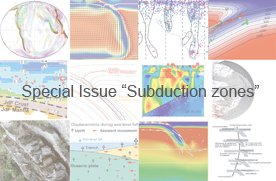Plate kinematics in the Cantabrian domain of the Pyrenean orogen
Abstract. The Cantabrian domain represents the western portion of the Pyrenean orogen, in the area where the Iberian continental lithosphere was subducted toward the north underneath the transitional to oceanic lithosphere of the Bay of Biscay. There, the about 100 km of orogenic convergence have been mostly accommodated in the northern portion of the orogen (i.e. the retro wedge) developed in the Bay of Biscay abyssal plain, while only crustal-scale folding with limited internal deformation occurred in the Cantabrian southern wedge (pro-wedge). Integrated meso- and macrostructural analyses and a reappraisal of available information from the transitional area between the Pyrenean and Cantabrian domains are presented in this work, allowing to set geometric and kinematic constraints on the entire Meso-Cenozoic history of the northern portion of the Iberian Plate, including subduction initiation and evolution in the western portion of the Pyrenean orogen.
The structural record of the Late Jurassic to Early Cretaceous deformation stage, which was associated with rifting and seafloor spreading in the Bay of Biscay, indicates a ridge perpendicular (NNE-SSW oriented) extension, with no evidence of relevant strike-slip components during rifting. A Cenozoic NNW-SSE oriented shortening stage followed, related to the limited (about 100 km) north-directed subduction of the Iberian continental lithosphere underneath the transitional to oceanic lithosphere of the Bay of Biscay. Subduction led to the formation of the poorly-developed Cantabrian pro-wedge, which is laterally juxtaposed to the well-developed Pyrenean pro-wedge to the east. During this convergence stage, the structural framework in the Cantabrian pro-wedge, and particularly along its transition with the Pyrenean wedge to the east, was severely complicated by the reactivation of Paleozoic and Mesozoic inherited structures.
Data presented in this work fully support the development of the Cantabrian Mountains as related to indentation and consequent thickening of the Bay of Biscay transitional lower crust during north-directed subduction of Iberian continental lithosphere. In essence, the Cantabrian pro-wedge is a lithospheric south-verging fault-propagation anticline developing above the subduction plane. The structural record in the area indicates that a lithospheric fault-propagation folding stage was predated, during the very early stages of orogenic shortening, by the development of a lithospheric-scale open syncline overlying the nucleation point of lithosphere sinking. Such a syncline is today partially preserved and represents one of the few natural examples of subduction initiation.






